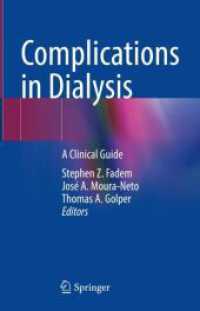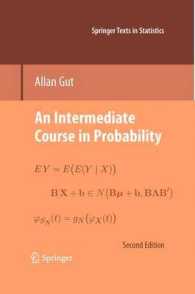- ホーム
- > 洋書
- > 英文書
- > Science / Mathematics
Full Description
The aim of the Protein Reviews is to serve as a publication vehicle for review articles that focus on crucial current vigorous aspects of protein structure, function, evolution and genetics. The volumes will appear online before they are published in a printed book. Articles are selected according to their importance to the understanding of biological systems, their relevance to the unravelling of issues associated with health and disease or their impact on scientific or technological advances and developments.
Volume 19 focusses on Purinergic receptors, also termed purinoceptors. These are plasma membrane proteins present in nearly all mammalian tissues. They participate in a number of cell functions that include proliferation and migration of neural stem cells, vascular reactivity, apoptosis and cytokine secretion and have been associated with learning and memory, feeding conduct, movement and sleep. They facilitate relaxation of smooth muscle of the gut in response to adenosine (P1 receptors) or ATP (P2 receptors).
The chapters in this volume are authored by experts in the field. They deal with aspects of structure and biological activity of selected receptor proteins. The first chapter in this volume reviews the current research on the Mechanism of channel gating and regulation of the activity of calcium-activated chloride channel ANO1. This is followed by a chapter dealing with Structure and function of the two-component cytotoxins of Staphylococcus aureus and a chapter on Membrane Fusion and Infection involving the Influenza virus Hemagglutinin. The fourth chapter reviews the impact of arrhythmogenic mutations through the structural determination of the L-type voltage-gated calcium channel. Then there is a chapter that discusses some open questions pertaining to histone post-translational modifications and nucleosome organization in transcriptional regulation. The next chapter deals with regulation of the extracellular SERPINA5 (protein C inhibitor) penetration through cellular membranes. This is followed by a chapter on coding of Class I and II aminoacyl-tRNA synthetases; a chapter on regulation of nephrin phosphorylation in diabetes and chronic kidney injury and a chapter on The Structure-Forming Juncture in oxidative protein folding and the events in the ER. Finally the last chapter deals with the polyspecificity of anti-lipid antibodies and its relevance to the development of autoimmunity. This volume is intended for research scientists, clinicians, physicians and graduate students in the fields of biochemistry, cell biology, molecular biology, immunology and genetics.
Contents
(1) Introduction to the Special Issue on Purinergic Receptors.- (2) ATP-Gated P2X3 Receptors Are Specialised Sensors of the Extracellular Environment.- (3) The P2X7 receptor.- (4) P2X Receptor Activation.- (5) P2Y1 Receptors - Properties and Functional Activities.- (6)P2Y2 Receptor Functions in Cancer: A Perspective in the Context of Colorectal Cancer.- (7) P2Y11 receptors : properties, distribution and functions.- (8) Structure, Pharmacology and Roles in Physiology of the P2Y12 Receptor.- (9) An Update on P2Y13 Receptor Signalling and Function.- (10) Pharmacological Properties and Biological Functions of the GPR17 Receptor, a Potential Target for Neuro-Regenerative Medicine.- (11) Biochemical and Pharmacological Role of A1 Adenosine Receptors and Their Modulation as Novel Therapeutic Strategy.- (12) Molecular mechanism of plant recognition of extracellular ATP.







